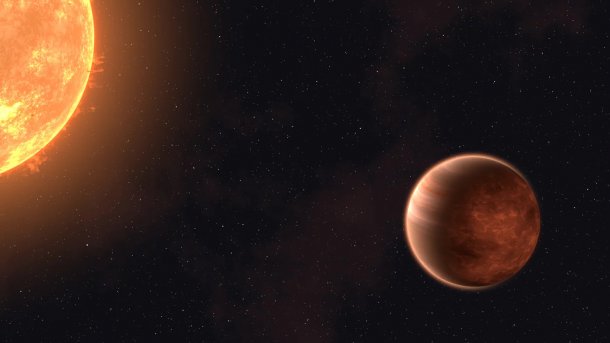Astronomy: Exoplanet WASP-43b with clouds of liquid rock
Further measurements of exoplanet WASP-43b reveal it as an extremely harsh world, building on initial compositional details.
(Bild: T. Müller (MPIA/HdA)/ CC BY-SA 4.0 Deed)
The exoplanet WASP-43b, which orbits closely around its star, has two strongly divergent halves and on the half facing away from the star, immense storms under clouds of liquefied rock or metal prevent chemical reactions. This is how an international research team describes what observation data from the James Webb Space Telescope has revealed about the celestial body. According to the data, the temperatures on the planet are between around 600 and 1250 degrees Celsius, which is why the "hot Jupiter" does not resemble the largest planet in our solar system at all, apart from its mass and size. The analysis was possible because the Mid-Infrared Instrument (MIRI) works in a similar way to a non-contact thermometer, explain those responsible.
Detailed insight possible
WASP-43b is around 280 light years away from us and takes around 20 hours to orbit its star. It is therefore extremely close to it and at the same time passes in front of it from our perspective. The researchers have now taken advantage of this again, as it was already possible to detect hydrogen on the day side of the exoplanet with the Hubble Space Telescope. This was possible with measurements taken while the exoplanet was directly next to the star from our perspective, before and after it disappeared behind it. For analyses of the night side, on the other hand, the exoplanet is analysed before, during and after it passes in front of the star. Only the James Webb Space Telescope was sensitive enough for this.
The spectral measurements of the exoplanet have therefore revealed that there is no methane on the night side. However, this should be produced there by chemical reactions of hydrogen and carbon monoxide, which typically occur on such celestial bodies - but which could not be detected with the technology used. The team explains the absence of methane with the enormous wind speeds that must prevail between the side always facing the star and the side facing away from it. These would chase the substances across the night side at almost 9000 km/h, which is why there would not be enough time for chemical reactions to take place. They also believe that the night side, which is still very hot, is enveloped by clouds that should consist of liquid rock droplets.
Empfohlener redaktioneller Inhalt
Mit Ihrer Zustimmmung wird hier ein externes Video (Kaltura Inc.) geladen.
Ich bin damit einverstanden, dass mir externe Inhalte angezeigt werden. Damit können personenbezogene Daten an Drittplattformen (Kaltura Inc.) übermittelt werden. Mehr dazu in unserer Datenschutzerklärung.
Overall, the data revealed a "complex, inhospitable world with fierce winds and enormous temperature differences", summarizes co-author Laura Kreidberg from the institute. The unprecedented level of detail in this description is thanks to the James Webb Space Telescope. The research work now presented also underlines once again how diverse the climatic conditions on exoplanets can be, "and that the Earth is special in many respects". The NIRSpec near-infrared spectrometer of the James Webb Space Telescope will next be used to search for carbon monoxide on WASP-43b in order to further substantiate the hypothesis. The work to date is now presented in the journal Nature Astronomy.
(mho)
